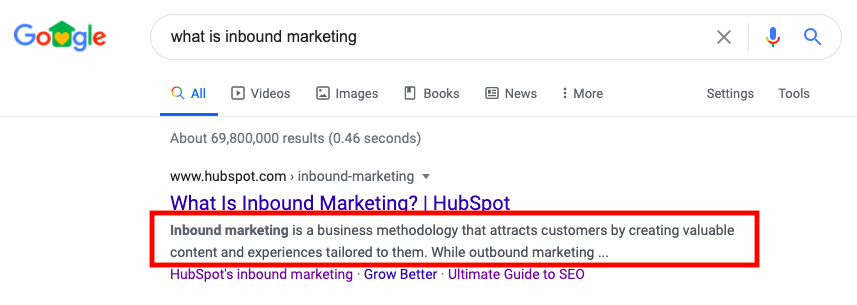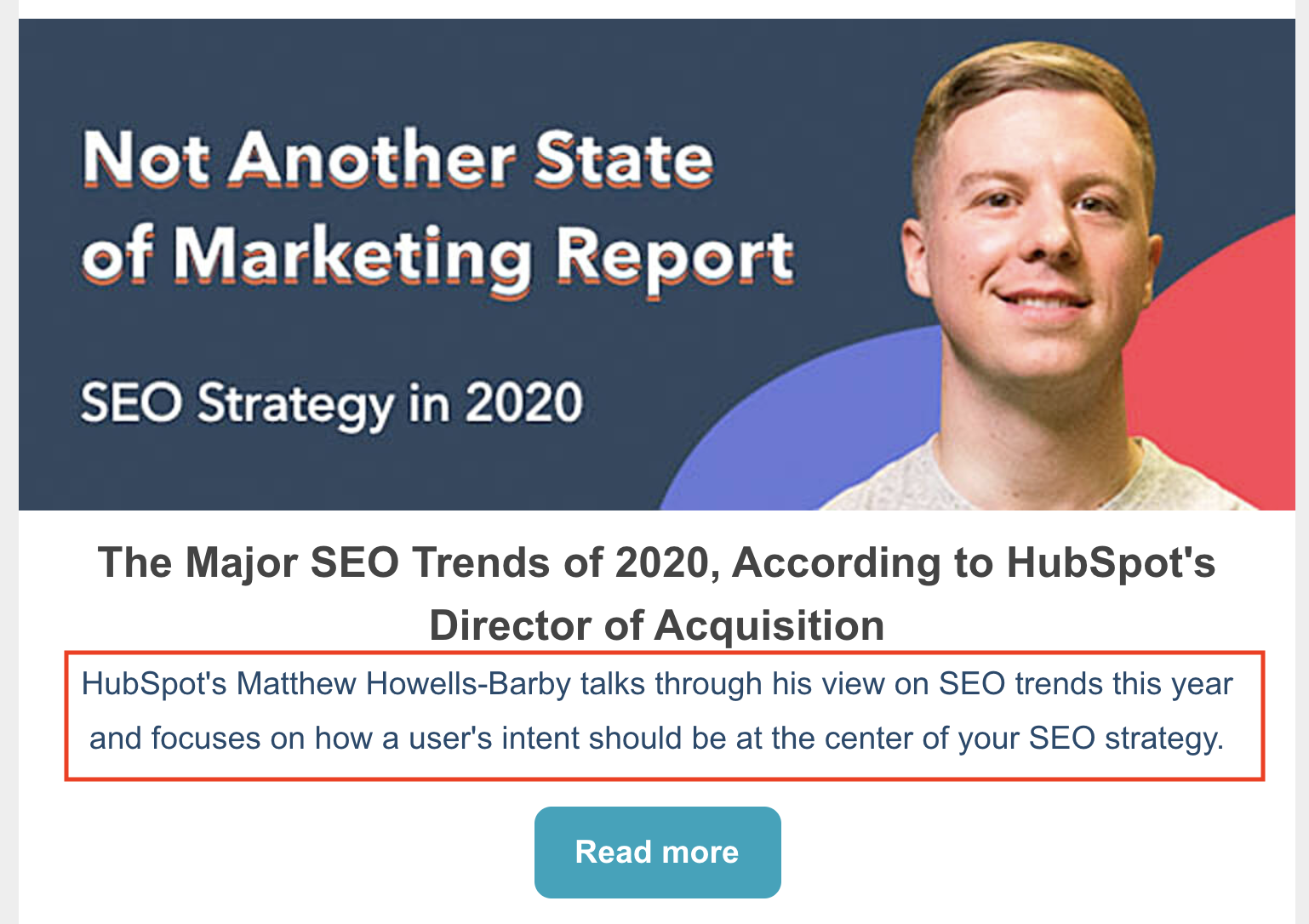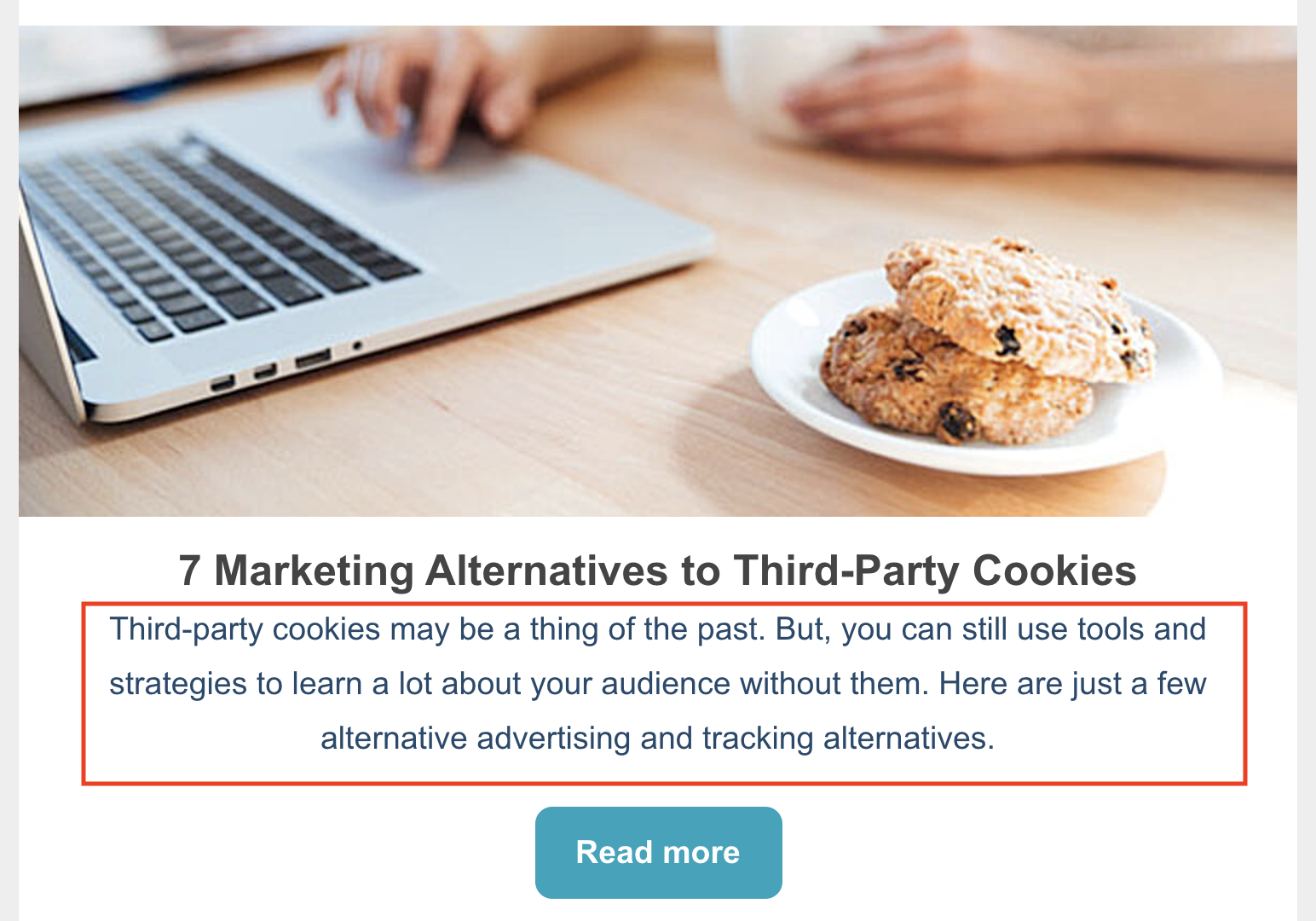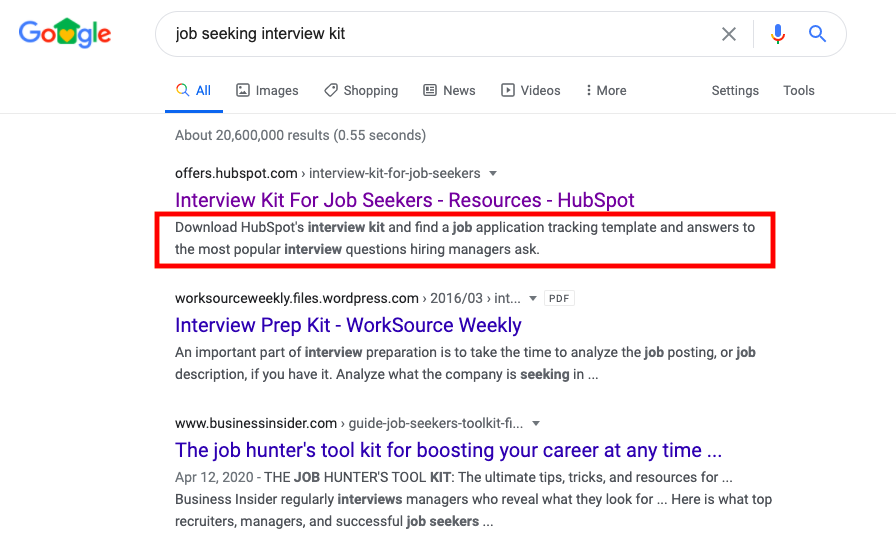I'll be the first one to admit it: The first time I wrote a blog post, I had a lot of new terminology to learn.
SEO, alt text, headers, all of it was new to me. Thankfully, learning how to use these acronyms to my advantage was a quick learning process.
However, there was one function of a blog post that took some time getting used to, and that was a meta description. At first, I didn't know the purpose of a meta description, and why it was so important that I should add one to a blog post.
"Google will show the accurate text of my blog posts in search results," I thought, "So there's no need for me to add meta descriptions, right?"
Not necessarily.
This post will show you why meta descriptions are important and how to write effective ones. Before all that, though, let's discuss what a meta description is.
What is a meta description?
A meta description is the snippet of information below the blue link of a search result. Its purpose is to describe the contents of the page to the searcher.
Any words that match the search term are bolded in the description. The end goal is to convince and persuade the searcher to click through to your website. Here is an example of a meta description as it would show up on a search engine results (SERP) page:
 Notice that, because the query is "What is inbound marketing?", the two words are bolded in that meta description.
Notice that, because the query is "What is inbound marketing?", the two words are bolded in that meta description.
Meta descriptions are important because they let Google know what your webpage will be about. If Google can read and comprehend the content of your meta description, they will have an easier chance of ranking your page to answer search queries.
🧡 TL;DR: Meta descriptions increase organic traffic and bring more eyes to your webpages.
If you don't include a meta description, Google will display a snippet of text from the first paragraph of your page. If there’s a search keyword in that text, it’ll be bolded. While this isn't a bad thing, not including a meta description means missing out on the chance to personalize the message you deliver to browsers.
Meta Description Examples
Meta descriptions should be quick, one- to two-sentence summaries of the content within your web page. They should tell the reader what they can expect to find after clicking on your link. For example, here’s a meta description for a data-driven marketing report:
 This meta description accurately describes what will be found in the report, who is presenting the information, and why the content will be helpful to readers. If browsers were typing in queries such as, "SEO trends in 2020," it's likely that this meta description will appear in their results.
This meta description accurately describes what will be found in the report, who is presenting the information, and why the content will be helpful to readers. If browsers were typing in queries such as, "SEO trends in 2020," it's likely that this meta description will appear in their results.
Meta descriptions follow a few simple rules: They're short, descriptive, and use keywords. But after that, you have free reign to play around with what they will say. Use this to your advantage when you're creating your meta description:
 If you know that your webpage will present content that's usually considered a bit dry, the way to engage browsers is to make a compelling meta description, like this one for third-party cookie alternatives. A meta description like this would make me interested in everything this post has to offer because it shows personality.
If you know that your webpage will present content that's usually considered a bit dry, the way to engage browsers is to make a compelling meta description, like this one for third-party cookie alternatives. A meta description like this would make me interested in everything this post has to offer because it shows personality.
Readers often check only the first page of results for their search queries. Because of this, where you rank on a webpage matters. Even though meta descriptions aren't the be-all, end-all that determines your rank, (you'll want to fully optimize On-Page SEO for that), they sure do help.
A great meta description has the potential to appear on the first page of results, and a great one might even be first, like this example below:

The meta description told Google how their page will fix the challenge of the query.
Now, you may be wondering if there's a secret key or formula to writing a perfect meta description, other than the rules above. While the secret key hasn't been located yet, there are some tips and tricks you can follow when writing your meta description. Let's talk about a few, next.
Meta Description Tips
Google suggests that a meta description should tell users what that web page is about. Based on the information in a meta description, the search engine ranks results on relevancy.
Think of meta descriptions as a pitch for your webpage. Communicate why the page will be helpful to the reader, and make sure it accurately reflects what's on the page. If a reader doesn't find what the meta description promises, they're probably going to click away.
Let's get into some tips for writing an amazing meta description.
1. Answer the question.
It's likely that people are on Google searching for an answer to a question. Try to get into their heads and think about what they're looking for that your content can help with.
Use your meta description to answer that question with a solution or benefit. For example, let's say your web page provides readers with a free template for writing standard operating procedures.
The question audiences will most likely Google is "What is an SOP?" Your meta description, then, should tell readers that they can use your guided template to learn how to write one. For instance, this would be my meta description if I were to write one to answer this query:
💻"Learn everything there is to know about writing a standard operating procedure (SOP), and find out how to write one that's amazing."
This meta description answers the question, and provides a little detail about the rest of the contents of the post.
2. Mention a solution to the challenge.
Provide a solution to the challenge your readers are looking to solve. For instance, if you're writing a blog post that's a listicle roundup of helpful CRM software, mention how many items are in the post and why that post will be valuable to readers.
If I were to write a meta description for a roundup, in this case, I would go with something like this:
💻"Discover the 15 best CRM software options for your small business and learn why they're great for simplicity, customer retention, and organization."
Remember, meta descriptions are the elevator pitch of your page — sell the content of your post in a way that will get readers to click. This description tells readers how many options they will read about and why they're important to know.
3. Keep the description concise.
The body of your page is where you’ll educate your audience, so the meta description doesn't need to be lengthy. Provide a quick summary of the page — or the point of the page that will stand out to readers. Meta descriptions should be under 160 characters long.
A good way to check the length of a meta description is to draft a tweet. Twitter limits you to 280 characters and lets you know when you reach your limit:
 If your description fills more than half of the circle in the tweet box, you should think about trimming it down. Meta descriptions should serve as a snapshot, not the body text of the post — save that for when the readers access your page.
If your description fills more than half of the circle in the tweet box, you should think about trimming it down. Meta descriptions should serve as a snapshot, not the body text of the post — save that for when the readers access your page.
4. Don't overuse the keywords.
While your meta description should have keywords, it also should read naturally to the reader. If you overuse keywords just to get a high rank, readers might not understand your meta description. A tough-to-follow description could turn a browser away from your page.
For example, let's say your webpage is delivering a content offer for interview materials and the primary keywords are "interview success," "tips for great interviews," and "interview preparation."
You could write a meta description that reads along the lines of, "An interview success offer that's free to download to be successful in preparing for interviews." However, this reads a little clunky and is hard to follow, right? Instead, try going with something more smooth:
💻"Learn the tips and tricks for acing interviews with this downloadable job seeking kit."
This description still uses two keywords, but also makes sense to the reader and gives them the background information they need to know how that offer page will help them.
5. Be engaging and unique to readers.
If you can, make your meta descriptions fun and engaging to read. Something eye-catching that will stop the reader from scrolling through a SERP. This is especially helpful if your webpage content is meant to be engaging and unique.
Match the tone of the content in your meta. Let's say the content for your webpage is a blog post about funny workplace memes. Your description of this could be straightforward and accomplish everything a meta description should, such as, "These 20 workplace memes are funny, timely, and shareable."
A description like that covers all of your bases, but it leaves the personality out. The post sounds like it was fun and interesting to put together, so that shouldn't stop with the body text! Instead, try this more compelling approach:
💻 "Brighten your work day with these fresh, fun memes that any professional can relate to. Cat videos, anyone?"
A description like that sells your content, tells readers what they can expect, and still manages to be interesting in just two sentences.
Your meta description is your chance to win over readers. Be sure to create an engaging meta description for your website that persuades people to choose your content first. After all, if your webpages are made to be helpful and valuable to browsers, so should the content that's describing it.
No comments:
Post a Comment